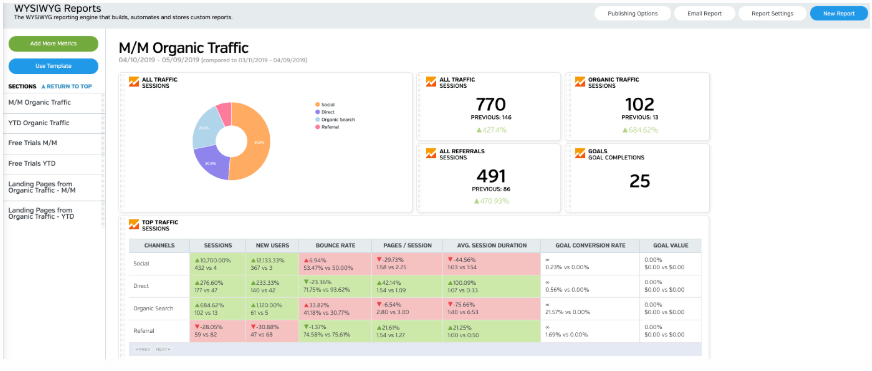After helping hundreds of marketing agencies with their reporting processes, I’ve seen a recurring theme. Reporting isn’t too fun.
- It’s as fun as taxes.
- It’s as fun as spreadsheets.
- It’s as fun as data entry.
But there’s a danger in this thinking. Done right, reporting isn’t just a mundane task. It’s an extremely powerful marketing strategy.
Marketing Reports are More than a Pretty Face
How many clients would fall off your radar if it wasn’t for an upcoming report you needed to prepare? It’s hard to find a better fail-safe to ensure clients are getting at least the minimum attention they need.
Reporting plays a critical role as the structural framework for educating and engaging with clients, and in many ways, nailing a well-crafted report is more important than writing your next blog post. Here’s why.
Reporting isn’t just a list of things that happened. It’s analysis with data as its supporting evidence. Specific analysis about how to generate more business is more valuable to someone than generic advice or information. What’s more powerful to a client than providing a specific blueprint for exactly how to bring in more money?
This is why we should elevate reporting beyond our list of chores and into the realm of content marketing strategy. And lest you suspect I just tacked on the latest buzzword onto reporting to dress it up, let’s examine the definition.
The way Content Marketing Institute defines content marketing is helpful.
Content Marketing
Content Marketing is a strategic marketing approach focused on creating and distributing valuable, relevant, and consistent content to attract and retain a clearly-defined audience — and, ultimately, to drive profitable customer action.
If we agree that’s what content marketing is, we can deduce whether reporting is a type of content marketing by seeing if reporting also holds up to the definition of content marketing.
Definition of Content Marketing Broken Down
Here’s the test. Does reporting live up to the definition of content marketing?
Content Marketing is a strategic marketing approach
Is reporting a strategic marketing approach? Yes. The time invested in reporting attracts new clients and keeps them around longer. You shouldn’t only be marketing to prospects since it’s easier to keep a client than find a new one.
focused on creating and distributing valuable, relevant, and consistent content
Is reporting a type of content that is valuable and relevant? Yes. It provides a client-specific analysis of what’s being done to attract more customers. Is it consistent? Yes. Clients with active marketing campaigns are generally sent weekly or monthly reports.
to attract and retain a clearly-defined audience
Is the aim of reporting to attract and retain a certain audience? Yes. New business development reports like a report of on-page SEO issues is done to attract new clients. The aim of reports for current clients is to keep them engaged, educate them, and ultimately lead them through future marketing opportunities.
— and, ultimately, to drive profitable customer action.
Is reporting done to ultimately drive profitable customer action? Yes. The goal of reporting to current clients is to build trust, prove value, and educate your client so they are more willing to do things like work with you on future projects and recommend you to others.
Elevate Your Reporting
Crafting a marketing report has just as much impact as writing an article. An article is typically for a broader audience of prospects, whereas a report has laser-focused content exactly for someone already in a business relationship with you. Both nurturing current clients and finding new clients equally deserve your energy.
If reporting is currently an afterthought, here’s how to create a reporting process focused on engaging clients:
- Keep it short. The shorter your report, the more likely it will be read and acted upon.
- Remove fluff. Only report on the few metrics that matter, so there aren’t distractions.
- Lead. Aim to include just as much analysis as data. What actions do you need from your client?
- Teach. Include an infographic or video in each report based on where your campaign is headed.
- Follow up. Include a question in each report so you have a reason to follow-up if a client becomes distant.
Once we get out of the mindset of reporting simply being a data dump and start seeing how valuable it is, we can infuse reports with the same amount of energy we put into all our content marketing.
Reports are not simply information. They are an educational tool that develops trust and ultimately fosters deeper, more profitable business relationships.

White Labeled and Branded Reports. Drag and Drop Editor. Automate your SEO, PPC, Social, Email, and Call Tracking Reporting.




